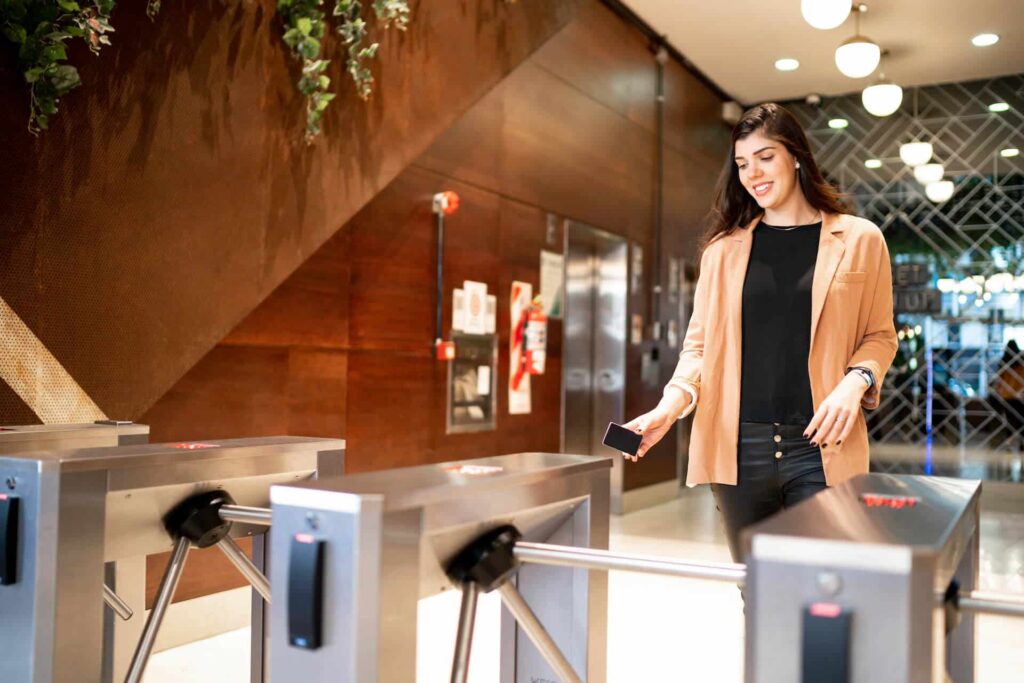The smart workplace: 7 elements of an intelligent workspace

Creating a smart workplace is an essential process for any company looking to embrace hybrid or flexible working.
But don’t worry: creating an ‘intelligent workspace’ isn’t as futuristic as it sounds. Instead, it’s about combining the latest technology into one user-friendly ecosystem. The goal is creating a more positive and connected employee experience.
In this article, we explore the benefits of a smart workplace. We also look at seven technologies that can help create a more intelligent workspace.
What is a smart workplace?
At its most basic level, a smart workplace is a well-connected one. It uses technology in conjunction with human-centric workplace strategy to improve employee experience.
Yes, it might share some similarities with your smart kitchen or smart home. Especially in the area of IoT sensors and the latest gadgets.
But unlike your kitchen, an intelligent workplace isn’t just one where devices are hooked up to the internet of things.
An intelligent workplace is one where facility managers (FMs) and decision-makers actively plan to improve and connect all elements of both the physical work environment and the digital workspace. And they do this using a wide range of smart workplace technology.
In an intelligent workspace, employees are treated like customers, and their customer experience matters. Any new digital workplace solutions are carefully considered. They’re only implemented if they actually improve workplace experience and employee engagement (i.e.: if they serve their customers well).
And critically, a smart workplace is one that collects real-time data on how people interact with both the physical and digital environments. Companies can then use this data to improve strategic space management and facility planning in general.
In a smart workplace, of course you can expect to see ‘smart,’ cutting-edge technology.
But a truly smart workplace is one where this technology serves a greater purpose. It serves the people that use it.
Smart workplaces vs smart buildings
‘Smart workplaces’ may be confused with ‘smart buildings.’
While the two are related, they are not synonymous.
Like we’ve covered, a smart workplace is one that uses smart technology in conjunction with the latest collaboration strategies in the workplace to connect employees, streamline workplace management, and improve workflows.
A smart building also uses smart technology, but with the more simple (but still important) goal to improve efficiency. Whether the plan is to save money or to reduce the carbon footprint (or both), smart buildings tend to focus on optimizing building automation systems to improve key operations. Therefore, smart buildings with IoT usually focus on optimizing things like HVAC systems, energy management, and security in building automation systems. They can also help improve facility management maintenance, especially in the areas of predictive and preventive maintenance.
As such, smart buildings may be part of a smart workplace strategy. And in some cases they may use similar technologies.
But only smart workplaces are specifically focused on creating a more connected workplace for workers.
Why are workplaces becoming smarter?
Workplaces are becoming smarter for one simple reason: they have to.
Hybrid work is increasingly becoming the norm in today’s workplace. This in large part, thanks to its positive impact on employee engagement and both talent attraction and retention efforts.
But despite its many benefits, there are many challenges of hybrid working, too. Plus, as the pandemic taught everyone, workplace agility is no longer a ‘nice to have’ (if it ever was). In today’s world, it’s a necessity.
To adequately respond to these new workplace trends, and to adequately manage widely distributed work and overlapping hybrid schedules, more and more companies are leaning into smarter tools and strategies. In fact, the global smart workplace market is expected to reach $53.36 billion in 2025.
“As you multiply your number of sites and you introduce more flexible work arrangements, your complexity grows,” says Kathleen Williams, Senior Product Manager at OfficeSpace Software. “It’s hard to keep a pulse on what’s actually happening across different locations and a distributed workforce without advanced workplace analytics and an intelligent workspace.”
Finally, remember that to be truly ‘smart,’ companies should be collecting workplace analytics about office use and technology adoption.
When hybrid leadership collects this type of data, they’re able to see what’s actually happening in the office.
And when they see what’s actually happening in the office, they can manage better hybrid workplace change strategies and improve the user experience for everyone.
That’s why many companies currently working to develop their own hybrid work model are starting the process by testing out different approaches. They can then collect smart data and use it to develop a reality-based workplace solution that fits with their unique culture and employee needs.
As more companies shift to a smart hybrid working model, the demand for a smart workplace keeps growing.
Dr. Jeremy Nunn, Forbes

What are some of the benefits of a smart workplace?
Many of the benefits of creating a smart workplace are the ripple effects of fostering more positive employee engagement. And workplace strategists all agree that employee engagement is good for everyone involved.
For example, according to research from the Economist, even before the Great Resignation, senior management at 81% of companies were focused on enhancing the employee experience. Meanwhile, Gallup research finds that companies that get employee engagement right enjoy 10% higher customer metrics, 17% more productivity, and 21% more profitability. Their earnings per share growth is also more than four times higher than their competitors.
Beyond this, when managed properly, companies can expect to see any or all of the following benefits from a smart digital transformation:
- Corporate real estate optimization, helping to right-size the real estate portfolio to account for both growth or less demand for on-premises space
- Improved workflows and more collaboration in the workplace
- Increased innovation in the workplace
- Improved sustainability
- Improved space utilization and a more modern office floor plan
- More empowerment in the workplace and workplace wellbeing
- A more inclusive company culture
- Better workplace agility, making it easier to adapt to new flexible work arrangements as the need arises
- Easier office move management
- A better overall hybrid workplace experience

What types of technology have recently changed the workplace?
More and more companies are using hybrid workplace technology to help fuel workplace transformation.
But all the latest collaboration tools and technology are not enough on their own to make a smart office.
It’s only when those smart tools are combined with workplace reports and analytics that the functionality of the office actually starts to increase.
So while fancy new gadgets and mobile devices will always garner plenty of media coverage, it’s really the technology that provides data and metrics around office use that is dramatically changing the workplace.
Agile working, activity-based working, office neighborhoods …There’s virtually no advanced workplace solution that can work without advanced workplace data.
Specifically, the following seven well-integrated technology solutions are changing the way companies can (and should) collect data and approach the smart workplace.
1. Desk booking software
New seating strategies like hot desking and office hoteling are having profound impacts on employee experience, dramatically boosting employee autonomy. But this type of seating is only really manageable with good desk booking tools (i.e.: cloud-based desk booking software).
Especially if this software is available via mobile app and uses APIs to integrate with technology like Microsoft Teams and Slack, it can simplify desk bookings and send notifications as necessary.
This can help ensure that employees are always able to find and access the type of workspace they prefer.
Similarly, office neighborhood software can help simplify who sits where on what day when companies embrace working neighborhoods.
Ultimately, any form of free addressing seating, where employees don’t have assigned seating, will only work as intended if employees can access unassigned seats easily. Desk booking software is the best tool for accomplishing this. And desk booking also collects data on desk utilization that companies can use in decision-making later on.
2. Room booking software
Similarly, room booking software can bring this functionality to collaboration spaces in the office, big or small.
A smart workplace will be one that removes any barriers to connecting with co-workers. Since employees will need an easy way to reserve, check-in, and cancel rooms, meeting room booking software is quickly becoming an essential of a smart office
It also dovetails with meeting room digital signage and other modern best practices in meeting room design. All of which will ideally create a more intelligent workspace, too.
3. IoT sensors
Desk booking data and employee self-reports are important facility management KPIs to track. But on their own, they may not account for the growing complexity of the smart and/or hybrid office.
“With the office becoming more complex, people need more from their data,” says Williams. “My advice to companies is that you can’t rely on just one source of data. You need to be able to look across your information silos and break them down as much as possible. You need to bring your large datasets together to truly solve business problems.”
This is why smart companies are now also using sensors to collect granular data about office and building use.
For example, an occupancy sensor can provide a much more reliable occupancy rate than you’d get by simply walking the floor.
Of course, sensors work best when they integrate with systems a company is already using.
OfficeSpace, for example, integrates with sensor industry leaders Vergesense, SenzoLive, Open Path, and Brivo.
4. Employee badge data
Along with office sensors, many companies are also implementing badge systems to collect granular employee badge data about how people are actually using the office
These systems were once used primarily for managing access control.
But many companies, especially those with hybrid teams, now also use them to better understand how the office is being used, and by who and when.
In fact, OfficeSpace clients use badge swipe data to track on-site activity use more than they do any other metrics.
5. Digital wayfinding
All the artificial intelligence in the world won’t help in a workplace where people struggle to get around, or to find the people and resources they need.
Plus, when people use the office less frequently, it’s more challenging to align schedules and keep everyone connected.
In short, wayfinding matters more than ever in a smart workplace. So many companies (especially those that have large and/or many physical workplaces, or that allow for remote work) are moving away from just placing simple placards here and there.
Instead, they’re embracing digital wayfinding signage and wayfinding kiosks throughout their facilities. They may also use a visual directory to help employees connect with the people they need, dramatically boosting visibility in a dynamic workspace.
And again, any wayfinding tools will work best when companies integrate them with the IWMS and can collect their own workplace data.
6. Stack and scenario planning tools
Getting the office right today is a test and iteration process. The more companies can test ideas with small changes, the more confidence they can have with the big ones.
Implementing changes of any size are dramatically simplified when space planners have tools for office scenario planning and stack planning. Using these tools can help companies follow space management best practices while implementing any changes.
7. Facility management software
Finally, stack and scenario planning software will work best when it’s part of overarching facility management software.
Cloud-based flexible working software can simplify all areas of facility management, helping to ensure that employees always have what they need to manage their workloads and stay connected.
Ideally, facility management software will also collect all the aforementioned data to help improve employee experience along with real estate management.

What is the future of the workplace?
The future of the workplace is one where data is continuously collected in a smart feedback loop, and used to make adjustments — big and small — to improve workflows and employee experience. the impact of technology in the workplace is carefully monitored …
Remember that a workplace solution isn’t ‘smart’ because it connects to the company intranet, embraces machine learning or virtual reality, or otherwise has that ‘wow’ factor you get from technology.
A workplace solution is smart when it is backed up by data from multiple sources, and when it ‘plays nice’ with other processes in the office. The most successful workplace teams are those who have smart tools in conjunction with carefully considered workspaces and workdays.



